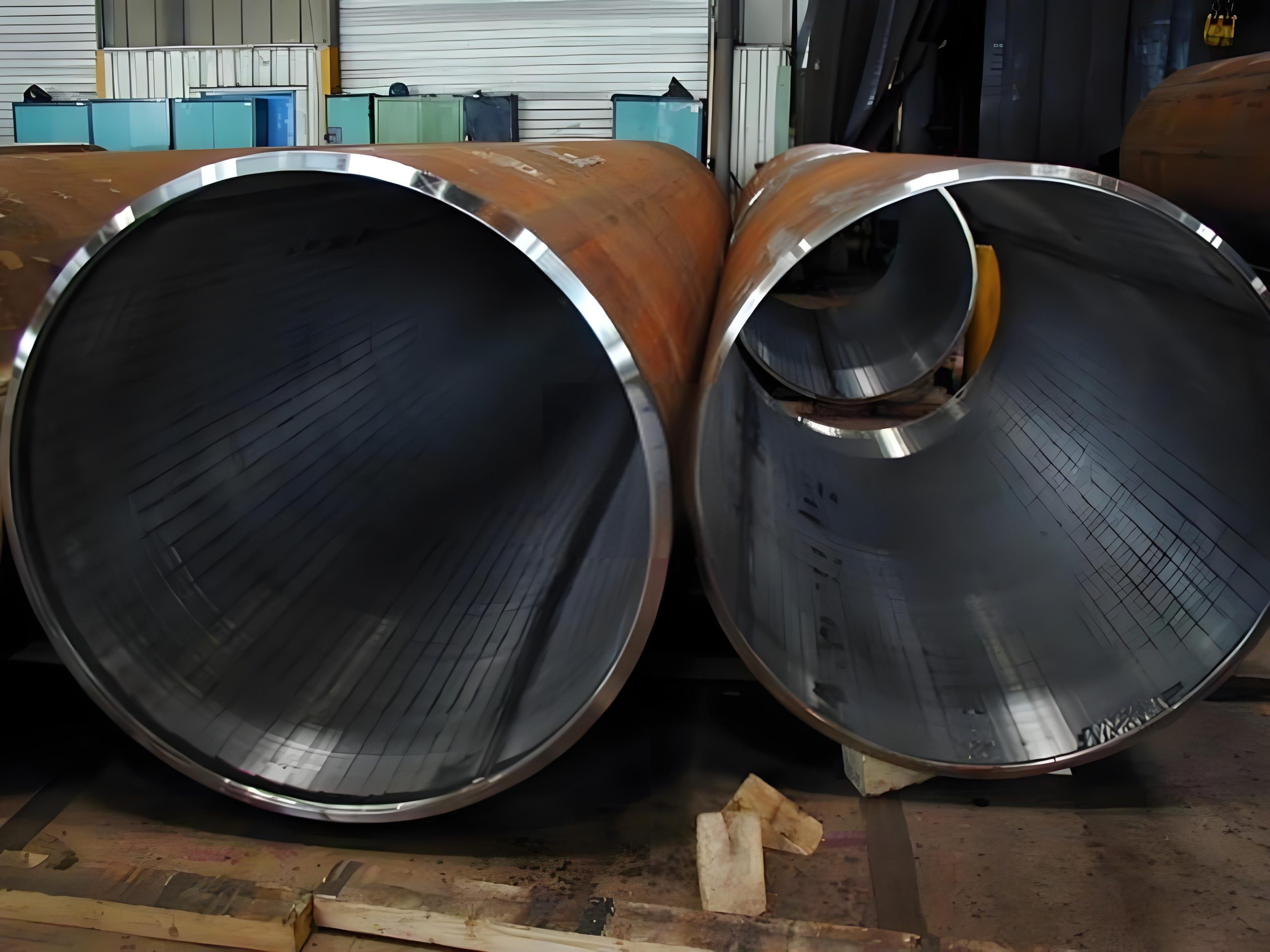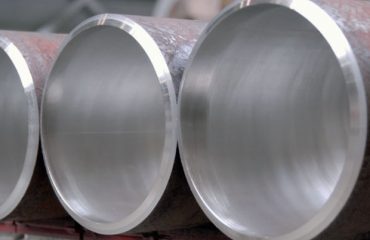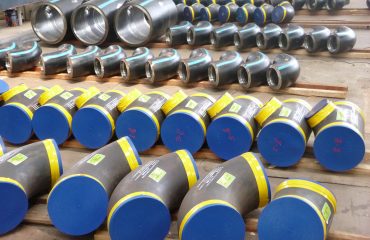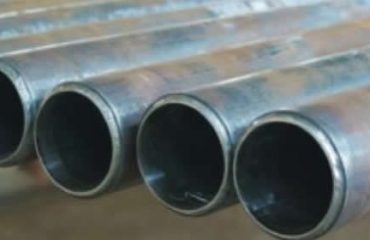
ข้อกำหนดท่อหุ้ม
ท่อหุ้ม, หรือที่เรียกว่าท่อหุ้มหรือ CRA (ทนต่อการกัดกร่อนโลหะ) ท่อหุ้ม, ประกอบด้วยท่อฐานเหล็กกล้าคาร์บอนหรือโลหะผสมที่มีชั้นโลหะผสมที่ทนต่อการกัดกร่อนภายในหรือภายนอก. ท่อเหล่านี้รวมความแข็งแรงทางกลของฐานเหล็กเข้ากับความต้านทานการกัดกร่อนของโลหะผสม, ทำให้เหมาะสำหรับสภาพแวดล้อมที่รุนแรงในอุตสาหกรรมต่างๆ เช่น น้ำมันและก๊าซ, กระบวนการทางเคมี, และการผลิตไฟฟ้า.
ข้อมูลจำเพาะที่สำคัญ
-
วัสดุฐาน:
- API 5L เกรด B, X42, X46, X52, X56, X60, X65, X70, X80
- ASTM A106 Gr นบี, มาตรฐาน ASTM A333 GR.6, โลหะผสม ASTM A335 Cr-Mo (P5, P11, หน้า 22, P9, P91)
-
วัสดุหุ้ม:
- สแตนเลส: เอสเอส 304/304L, เอสเอส 316/316L, เอสเอส 317/317L, พิมพ์กลับหน้า 2205, พิมพ์กลับหน้า 2506, ซูเปอร์ดูเพล็กซ์ 2507, โลหะผสม 254 เราคือ, 904L
- เหรียญเซนต์ alloys: Incoloy 825, INCONEL 625, INCONEL 59, โลหะผสม 31, AL6XN, โลหะผสม 20, Monel 400
- โลหะผสมอื่น ๆ: แฮสเทลลอย ซี-276, เกรดไทเทเนียม 2, 5, 7, 9, 12, เซอร์โคเนียม R60702, โลหะผสมทองแดงต่างๆ
-
มาตรฐานการผลิต:
- API 5LD
- ASTM A240, A263, A264, A265, B898, B424, B443, B619, B622, B675, B265, B551
-
มิติ:
- ช่วงเส้นผ่านศูนย์กลางท่อ: Ф50มม.-Ф1800มม
- ความหนาของผนังซับ: 0.5มม.-3.5มม
- ความยาว: ≤15ม
-
การรักษาพื้นผิว:
- เทคโนโลยีคอมโพสิตการยุบตัวใต้น้ำแบบดิจิตอล
- เทคโนโลยีคอมโพสิตไฮดรอลิก
- การปูผิวปลายท่อและการคว้านผนังด้านใน
-
การตรวจสอบและทดสอบ:
- การทดสอบอัลตราโซนิก (OUT)
- การทดสอบภาพรังสี (RT)
- การทดสอบอุทกสถิต
- การทดสอบทางกล (แรงดึง, ความแข็ง, ผลกระทบ)
- การทดสอบการกัดกร่อน
กระบวนการหุ้มท่อ
การหุ้มเกี่ยวข้องกับการยึดโลหะผสมที่ทนต่อการกัดกร่อน (ด้าย) กับท่อฐานเหล็กกล้าคาร์บอนหรือโลหะผสม. กระบวนการนี้สามารถทำได้ด้วยวิธีการต่างๆ, แต่ละอันมีข้อดีและการใช้งานของตัวเอง:
วิธีการหุ้ม
-
รีดร้อน:
- เกี่ยวข้องกับการรีด CRA และวัสดุฐานเข้าด้วยกันที่อุณหภูมิสูงเพื่อให้ได้พันธะทางโลหะวิทยา.
-
การรีดร่วม:
- วัสดุทั้งสองถูกอัดเข้าด้วยกัน, มั่นใจได้ถึงความผูกพันอันแน่นแฟ้นผ่านการเสียรูปไปพร้อม ๆ กัน.
-
เชื่อมซ้อน:
- CRA ถูกเชื่อมเข้ากับวัสดุฐาน, สร้างชั้นโลหะที่ทนต่อการกัดกร่อน.
-
พันธะระเบิด:
- ใช้การระเบิดแบบควบคุมเพื่อยึด CRA กับวัสดุฐาน. วิธีนี้มีประโยชน์อย่างยิ่งสำหรับรูปร่างขนาดใหญ่หรือซับซ้อน.
-
ผงโลหะวิทยา:
- ผง CRA ถูกนำไปใช้กับวัสดุฐานแล้วเผาเพื่อสร้างพันธะ.
-
พันธะทางกล:
- เกี่ยวข้องกับการขยายหรือหดตัวซับ CRA เพื่อให้พอดีกับท่อฐานอย่างแน่นหนา. วิธีการนี้มีความแข็งแรงน้อยกว่าการยึดติดทางโลหะแต่มีประโยชน์สำหรับการใช้งานบางประเภท.
ขั้นตอนกระบวนการ
-
การเตรียมท่อฐาน:
- การทำความสะอาดและตรวจสอบท่อฐานเพื่อให้มั่นใจว่าเป็นไปตามมาตรฐานที่กำหนด.
-
การประยุกต์ใช้การหุ้ม:
- การใช้เลเยอร์ CRA โดยใช้วิธีใดวิธีหนึ่งที่กล่าวถึงข้างต้น.
-
การรักษาความร้อน:
- เพื่อบรรเทาความเครียดและสร้างความมั่นใจในการยึดเกาะระหว่างวัสดุอย่างแน่นหนา.
-
การตัดเฉือนและการตกแต่ง:
- การสร้างรูปร่างขั้นสุดท้าย, พื้นผิว, และการตรวจสอบให้ตรงตามข้อกำหนดด้านมิติและคุณภาพ.
-
การทดสอบและตรวจสอบ:
- การทดสอบที่ครอบคลุมเพื่อรับรองความสมบูรณ์และประสิทธิภาพของท่อหุ้ม.
ท่อหุ้มคืออะไร?
ท่อหุ้มเป็นท่อคอมโพสิตที่รวมความแข็งแรงเชิงกลของท่อคาร์บอนหรือท่อเหล็กอัลลอยด์กับความต้านทานการกัดกร่อนของชั้น CRA. กระบวนการหุ้ม cladding ผูกมัด CRA กับวัสดุฐาน, นำเสนอความทนทานและความต้านทานต่อสภาพแวดล้อมที่กัดกร่อน. ท่อเหล่านี้มีความสำคัญในอุตสาหกรรมที่มีทั้งความแข็งแรงเชิงกลและความต้านทานการกัดกร่อนเป็นสิ่งจำเป็น, เช่นน้ำมันและก๊าซ, petrochemical, และการใช้งานทางทะเล.
ช่วงขนาดของท่อเหล็กหุ้ม
ท่อเหล็กที่มีขนาดใหญ่มีหลายขนาดเพื่อตอบสนองความต้องการทางอุตสาหกรรมที่แตกต่างกัน:
- ช่วงเส้นผ่านศูนย์กลางท่อ: Ф50มม.-Ф1800มม
- ความหนาของผนังซับ: 0.5มม.-3.5มม
- ความยาว: ถึง 15 เมตร
ช่วงขนาดของท่อเหล็กหุ้ม (ต่อเนื่อง)
มิติเหล่านี้ทำให้มั่นใจได้ว่าท่อที่หุ้มด้วยการใช้งานสามารถปรับให้เข้ากับแอปพลิเคชันที่เฉพาะเจาะจงได้, ให้ความทนทานและความต้านทานการกัดกร่อนที่จำเป็นสำหรับการใช้งานที่ตั้งใจไว้. ความยืดหยุ่นในช่วงขนาดช่วยให้การปรับแต่งสามารถตอบสนองความต้องการเฉพาะของกระบวนการอุตสาหกรรมต่างๆ.
รายการราคาท่อหุ้ม
ราคาของท่อที่มีการหุ้มอาจแตกต่างกันไปตามปัจจัยหลายประการ, รวมถึงวัสดุพื้นฐาน, ประเภทของ CRA ที่ใช้, ขนาดของท่อ, และกระบวนการผลิต. นี่คือคู่มือทั่วไปเกี่ยวกับวิธีการที่ปัจจัยเหล่านี้มีผลต่อต้นทุน:
-
วัสดุฐาน:
- เหล็กกล้าคาร์บอน: โดยทั่วไปมีราคาถูกกว่า.
- โลหะผสมเหล็ก: ค่าใช้จ่ายที่สูงขึ้นเนื่องจากคุณสมบัติเชิงกลที่เพิ่มขึ้น.
-
วัสดุ CRA:
- สแตนเลส (เช่น, 304/304L, 316/316L): ค่าใช้จ่ายปานกลาง.
- เหรียญเซนต์ alloys (เช่น, INCONEL 625, แฮสเทลลอย ซี-276): ค่าใช้จ่ายที่สูงขึ้นเนื่องจากความต้านทานการกัดกร่อนที่เหนือกว่า.
- โลหะผสมพิเศษ (เช่น, ไทเทเนียม, เซอร์โคเนียม): ค่าใช้จ่ายสูงสุดเนื่องจากคุณสมบัติที่ไม่ซ้ำกัน.
-
ขนาดท่อ:
- ขนาดเส้นผ่าศูนย์กลางที่ใหญ่ขึ้นและผนังที่หนาขึ้นเพิ่มต้นทุนวัสดุ.
- ท่อที่ยาวขึ้นต้องการกระบวนการผลิตที่กว้างขวางมากขึ้น.
-
กระบวนการผลิต:
- วิธีการเชื่อมทางกลง่ายมีราคาไม่แพง.
- กระบวนการขั้นสูงเช่นพันธะระเบิดหรือการซ้อนทับการเชื่อมนั้นมีค่าใช้จ่ายสูงกว่า.
สำหรับราคาที่เฉพาะเจาะจง, ขอแนะนำให้ติดต่อผู้ผลิตหรือซัพพลายเออร์ที่สามารถให้คำพูดโดยละเอียดตามข้อกำหนดที่แน่นอนที่จำเป็น.
การรักษาพื้นผิวหุ้มท่อ
การรักษาพื้นผิวของท่อหุ้มเป็นสิ่งสำคัญเพื่อให้มั่นใจถึงอายุการใช้งานและประสิทธิภาพของท่อที่ใช้งาน. กระบวนการปรับสภาพพื้นผิวประกอบด้วย:
-
การทำความสะอาด:
- การกำจัดสิ่งปนเปื้อนใด ๆ, สนิม, หรือสะเก็ดจากพื้นผิวเพื่อให้แน่ใจว่าพื้นผิวการยึดเกาะสะอาด.
-
การหยาบผิว:
- เทคนิคต่างๆ เช่น การพ่นกรวดหรือการพ่นทรายใช้ในการทำให้พื้นผิวหยาบ, ปรับปรุงการยึดเกาะของชั้น CRA.
-
การประยุกต์ใช้ CRA:
- ชั้น CRA ถูกนำมาใช้โดยใช้วิธีการต่างๆ เช่น การซ้อนทับของการเชื่อม, รีดร้อน, หรือพันธะระเบิด.
-
การรักษาหลังการหุ้ม:
- การอบชุบด้วยความร้อนเพื่อลดความเครียดและเพิ่มความผูกพันระหว่าง CRA และวัสดุฐาน.
- การตัดเฉือนและการขัดขั้นสุดท้ายเพื่อให้ได้พื้นผิวที่ต้องการ.
-
การตรวจสอบและทดสอบ:
- การทดสอบแบบไม่ทำลาย (NDT) วิธีการต่างๆ เช่น การทดสอบอัลตราโซนิก (OUT) และการทดสอบด้วยภาพรังสี (RT) ใช้ในการตรวจสอบข้อบกพร่อง.
- การตรวจสอบด้วยสายตาเพื่อให้มั่นใจในคุณภาพพื้นผิว.
CRA วัสดุท่อฝัง
CRA cladded pipes ใช้วัสดุทนต่อการกัดกร่อนที่หลากหลาย, แต่ละตัวเลือกตามข้อกำหนดเฉพาะของแอปพลิเคชัน:
-
สแตนเลส:
- เอสเอส 304/304L, เอสเอส 316/316L, เอสเอส 317/317L
- พิมพ์กลับหน้า 2205, พิมพ์กลับหน้า 2506, ซูเปอร์ดูเพล็กซ์ 2507
- โลหะผสม 254 เราคือ, 904L
-
เหรียญเซนต์ alloys:
- Incoloy 825, INCONEL 625, INCONEL 59
- โลหะผสม 31, AL6XN, โลหะผสม 20
- Monel 400
-
โลหะผสมอื่น ๆ:
- แฮสเทลลอย ซี-276
- เกรดไทเทเนียม 2, 5, 7, 9, 12
- เซอร์โคเนียม R60702
- โลหะผสมทองแดงต่างๆ
ทางเลือกของวัสดุ CRA ขึ้นอยู่กับปัจจัยต่าง ๆ เช่นประเภทของการกัดกร่อน (เช่น, บ่อ, รอยแยก, การร้าวการกัดกร่อนของความเครียด), อุณหภูมิ, และสภาพแวดล้อมทางเคมี.
ประเภทของท่อหุ้ม
ท่อหุ้มสามารถจัดหมวดหมู่ตามวิธีการหุ้มและประเภทของ CRA ที่ใช้:
ขึ้นอยู่กับวิธีการหุ้ม
-
ท่อซ้อนทับกัน:
- CRA เชื่อมกับท่อฐาน, เหมาะสำหรับการใช้งานแรงดันสูง.
-
ท่อหุ้มที่ถูกผูกมัด:
- ใช้แรงระเบิดเพื่อผูก CRA กับท่อฐาน, เหมาะสำหรับรูปร่างที่ซับซ้อนและเส้นผ่านศูนย์กลางขนาดใหญ่.
-
ท่อชุดม้วนร้อน:
- CRA และวัสดุพื้นฐานจะถูกรีดเข้าด้วยกันที่อุณหภูมิสูง, สร้างความมั่นใจว่าพันธะโลหะที่แข็งแกร่ง.
-
ท่อที่มีกลไก:
- CRA liner ติดตั้งกลไกภายในท่อฐาน, ราคาไม่แพง แต่มีความแข็งแรงของพันธะที่ต่ำกว่า.
ขึ้นอยู่กับวัสดุ CRA
-
ท่อหุ้มสแตนเลส:
- ใช้กันทั่วไปสำหรับความต้านทานการกัดกร่อนที่ยอดเยี่ยมและคุณสมบัติเชิงกลของพวกเขา.
-
ท่อชุดโลหะผสมนิกเกิล:
- ทนต่อการกัดกร่อนสูงในสภาพแวดล้อมที่ก้าวร้าว, เช่นสภาพอุณหภูมิสูงและความดันสูง.
-
ท่อไทเทเนียม:
- ทนต่อการกัดกร่อนจากน้ำทะเลและสารเคมีมาก.
-
ท่อเซอร์โคเนียม:
- ใช้ในการใช้งานที่เกี่ยวข้องกับกรดที่แข็งแกร่งเนื่องจากความต้านทานการกัดกร่อนที่ยอดเยี่ยม.
การทดสอบท่อเหล็กและการตรวจสอบ (ต่อเนื่อง)
เพื่อให้แน่ใจว่าคุณภาพและความสมบูรณ์ของท่อหุ้ม, มีการทดสอบและการตรวจสอบที่ครอบคลุมในระหว่างและหลังกระบวนการผลิต. การทดสอบเหล่านี้ออกแบบมาเพื่อตรวจสอบคุณสมบัติเชิงกล, ความต้านทานการกัดกร่อน, และความน่าเชื่อถือโดยรวมของท่อ.
การทดสอบแบบไม่ทำลาย (NDT)
-
การทดสอบอัลตราโซนิก (OUT):
- ใช้ในการตรวจจับข้อบกพร่องภายในและวัดความหนาของชั้นหุ้ม.
- ตรวจสอบให้แน่ใจว่าไม่มีความไม่ต่อเนื่องหรือช่องว่างในพันธะระหว่างการหุ้มและวัสดุฐาน.
-
การทดสอบภาพรังสี (RT):
- ใช้รังสีเอกซ์หรือรังสีแกมมาเพื่อระบุข้อบกพร่องภายในเช่นรอยแตกหรือการรวม.
- ให้ภาพรายละเอียดของโครงสร้างภายในของท่อ.
-
ตรวจสอบอนุภาคแม่เหล็ก (MPI):
- เหมาะสำหรับการตรวจจับพื้นผิวและข้อบกพร่องใกล้พื้นผิวในวัสดุ ferromagnetic.
- ท่อถูกทำให้เป็นแม่เหล็ก, และอนุภาคเหล็กจะถูกนำไปใช้เพื่อเปิดเผยข้อบกพร่อง.
-
การตรวจสอบสีย้อม (DPI):
- สีย้อมของเหลวถูกนำไปใช้กับพื้นผิว, ซึ่งแทรกซึมข้อบกพร่องที่ทำลายพื้นผิวใด ๆ.
- สีย้อมส่วนเกินจะถูกลบออก, และนักพัฒนาถูกนำไปใช้เพื่อดึงสีย้อมออกจากข้อบกพร่องสำหรับการตรวจสอบด้วยภาพ.
การทดสอบทางกล
-
การทดสอบแรงดึง:
- วัดความต้านทานแรงดึง, ความแข็งแรงให้ผลผลิต, และการยืดตัวของท่อหุ้ม.
- ทำให้มั่นใจได้ว่าท่อตรงตามข้อกำหนดด้านทรัพย์สินทางกล.
-
การทดสอบความแข็ง:
- กำหนดความแข็งของทั้งการหุ้มและวัสดุฐาน.
- วิธีการทั่วไป ได้แก่ Rockwell, แรงของวัสดุ, และการทดสอบความแข็งของ Vickers.
-
การทดสอบผลกระทบ:
- ประเมินความเหนียวของวัสดุโดยการวัดความสามารถในการดูดซับพลังงานในระหว่างการแตกหัก.
- โดยทั่วไปจะดำเนินการที่อุณหภูมิต่างๆเพื่อจำลองสภาพการบริการ.
การทดสอบการกัดกร่อน
-
ทดสอบสเปรย์เกลือ:
- เผยให้เห็นท่อที่หุ้มด้วยสภาพแวดล้อมสเปรย์เกลือเพื่อประเมินความต้านทานต่อการกัดกร่อน.
- ใช้กันทั่วไปสำหรับสแตนเลสและโลหะผสมที่ทนต่อการกัดกร่อนอื่น ๆ.
-
การทดสอบการกัดกร่อน:
- ประเมินความไวของวัสดุที่หุ้มด้วยปรากฏการณ์การกัดกร่อนที่แปลเป็นภาษาท้องถิ่น.
- เกี่ยวข้องกับการเปิดเผยวัสดุไปยังสภาพแวดล้อมเฉพาะที่ส่งเสริมการกัดกร่อนของหลุมหรือรอยแยก.
-
การทดสอบการกัดกร่อนระหว่างเกรน:
- กำหนดความต้านทานของวัสดุที่หุ้มต่อการกัดกร่อนตามแนวขอบเขตของเกรน.
- สำคัญสำหรับวัสดุที่อาจสัมผัสกับอุณหภูมิสูงหรือสารเคมีที่มีฤทธิ์กัดกร่อน.
การตรวจสอบมิติและการมองเห็น
-
ตรวจสอบมิติ:
- ตรวจสอบให้แน่ใจว่าท่อหุ้มเป็นไปตามความคลาดเคลื่อนของขนาดที่ระบุ, รวมถึงเส้นผ่านศูนย์กลาง, ความหนาของผนัง, และความยาว.
- ใช้เครื่องมือเช่นคาลิปเปอร์, ไมโครมิเตอร์, และประสานงานเครื่องวัด (CMM).
-
การตรวจสอบด้วยภาพ:
- ดำเนินการเพื่อระบุข้อบกพร่องที่พื้นผิว, คุณภาพการเชื่อม, และรูปลักษณ์โดยรวม.
- โดยทั่วไปแล้วจะดำเนินการโดยผู้ตรวจสอบที่ผ่านการฝึกอบรมโดยใช้อุปกรณ์ช่วยการมองเห็นและเครื่องมือขยายภาพ.
การหุ้มท่อและความทนทานของฉนวน
ความทนทานต่อการหุ้มและฉนวนเป็นสิ่งสำคัญเพื่อให้แน่ใจว่าท่อหุ้มทำงานได้ตามที่คาดหวังในการใช้งานที่ต้องการ. มีการระบุความคลาดเคลื่อนสำหรับมิติและคุณสมบัติต่างๆ เพื่อรักษาความสม่ำเสมอและคุณภาพ.
ความคลาดเคลื่อนที่สำคัญ
-
ความทนทานต่อความหนาของการหุ้ม:
- ความหนาของชั้นหุ้มต้องสม่ำเสมอและอยู่ภายในขีดจำกัดที่กำหนด.
- ช่วงพิกัดความเผื่อโดยทั่วไปอยู่ระหว่าง ±0.1 ถึง ±0.5 มม, ขึ้นอยู่กับการใช้งานและวิธีการหุ้ม.
-
ความอดทนของเส้นผ่านศูนย์กลางท่อ:
- ตรวจสอบให้แน่ใจว่าเส้นผ่านศูนย์กลางภายนอกของท่อหุ้มเป็นไปตามข้อกำหนดที่ระบุ.
- ความคลาดเคลื่อนทั่วไปคือ ±1% ของเส้นผ่านศูนย์กลางระบุ.
-
ความทนทานต่อความหนาของผนัง:
- ความหนาของผนังทั้งหมด (วัสดุฐานบวกการหุ้ม) ต้องอยู่ภายในขอบเขตที่กำหนด.
- ความทนทานมาตรฐานคือ ± 10% ของความหนาของผนังที่ระบุ.
-
ความอดทนต่อความยาว:
- ความยาวโดยรวมของท่อหุ้มจะต้องตรงกับขนาดที่ระบุ.
- ความคลาดเคลื่อนโดยทั่วไปคือ ±50 มม. สำหรับความยาวสูงสุด 12 เมตร.
-
ความอดทนต่อการเกิดไข่:
- วัดค่าเบี่ยงเบนจากหน้าตัดวงกลมที่สมบูรณ์.
- ความทนทานต่อการเกิดไข่มักจะอยู่ภายใน 1-2% ของเส้นผ่านศูนย์กลางที่ระบุ.
-
ความอดทนต่อความตรง:
- ตรวจสอบให้แน่ใจว่าท่อตรงและไม่มีการโค้งงอมากเกินไป.
- ค่าเบี่ยงเบนที่ยอมรับได้โดยทั่วไปอยู่ภายใน 3-5 มิลลิเมตรต่อความยาวเมตร.
ข้อดีของท่อหุ้ม (ต่อเนื่อง)
-
ลดค่าใช้จ่าย:
- เมื่อเทียบกับการใช้ท่อ CRA ที่เป็นของแข็ง, ท่อหุ้มจะประหยัดกว่าเนื่องจากใช้วัสดุฐานที่มีราคาถูกกว่าแต่ยังคงให้ความต้านทานการกัดกร่อนที่จำเป็น.
-
ขยายอายุการใช้งาน:
- การผสมผสานระหว่างท่อฐานที่ทนทานและชั้นหุ้มที่ทนต่อการกัดกร่อนช่วยยืดอายุการใช้งานของท่อในสภาพแวดล้อมที่รุนแรงได้อย่างมาก.
-
ความเก่งกาจ:
- ท่อหุ้มสามารถปรับแต่งให้ตรงตามความต้องการเฉพาะได้, รวมถึงวัสดุหุ้มและความหนาที่แตกต่างกัน, ทำให้เหมาะสมกับการใช้งานที่หลากหลาย.
-
การบำรุงรักษาลดลง:
- ความต้านทานการกัดกร่อนที่เหนือกว่าของชั้นหุ้มช่วยลดความจำเป็นในการบำรุงรักษาและซ่อมแซมบ่อยครั้ง, ส่งผลให้ต้นทุนการดำเนินงานลดลงเมื่อเวลาผ่านไป.
-
ประสิทธิภาพการทำงานที่อุณหภูมิสูง:
- วัสดุ CRA หลายชนิดที่ใช้ในการหุ้มสามารถทนต่ออุณหภูมิสูงได้, ทำให้ท่อหุ้มเหมาะสำหรับการใช้งานที่อุณหภูมิสูง.
-
ความปลอดภัยที่ได้รับการปรับปรุง:
- ความแข็งแรงและความต้านทานการกัดกร่อนสูงของท่อหุ้มช่วยเพิ่มความปลอดภัยและความน่าเชื่อถือของท่อ, ลดความเสี่ยงของการรั่วไหลและความล้มเหลว.
ความแตกต่างทั่วไประหว่างท่อหุ้มและท่อมีเส้น
ในขณะที่ท่อทั้งแบบหุ้มและแบบมีเส้นได้รับการออกแบบให้ทนทานต่อการกัดกร่อน, พวกเขาต่างกันในการก่อสร้าง, ผลงาน, และแอปพลิเคชัน.
ห่มท่อ
-
ก่อสร้าง:
- ประกอบด้วยท่อฐานเหล็กกล้าคาร์บอนหรือโลหะผสมที่มีชั้น CRA เชื่อมติดกันทางโลหะวิทยา.
- กระบวนการหุ้มช่วยให้มั่นใจได้ถึงความผูกพันอันแน่นแฟ้นระหว่างวัสดุ.
-
ผลงาน:
- มีความแข็งแรงเชิงกลที่เหนือกว่าและทนต่อการกัดกร่อน.
- เหมาะสำหรับการใช้งานที่มีแรงดันสูงและอุณหภูมิสูง.
-
การใช้งาน:
- ใช้ในสภาพแวดล้อมที่รุนแรงเช่นน้ำมันและก๊าซ, petrochemical, และอุตสาหกรรมแปรรูปทางเคมี.
- เหมาะสำหรับการใช้งานที่ทั้งความแข็งแรงทางกลและความต้านทานการกัดกร่อนมีความสำคัญ.
-
ค่าใช้จ่าย:
- โดยทั่วไปจะมีราคาแพงกว่าท่อบุเส้นเนื่องจากกระบวนการผลิตที่ซับซ้อน.
ท่อเรียงราย
-
ก่อสร้าง:
- ประกอบด้วยท่อฐานเหล็กกล้าคาร์บอนหรือโลหะผสมที่มีซับ CRA ติดตั้งอยู่ภายใน.
- ไลเนอร์ไม่ได้ถูกผูกมัดทางโลหะกับท่อฐาน.
-
ผลงาน:
- ให้ความต้านทานการกัดกร่อนที่ดีแต่มีความแข็งแรงเชิงกลต่ำกว่าเมื่อเทียบกับท่อหุ้ม.
- เหมาะสำหรับการใช้งานที่มีแรงดันและอุณหภูมิต่ำ.
-
การใช้งาน:
- นิยมใช้ในการบำบัดน้ำ, น้ำเสีย, และการขนส่งสารเคมีแรงดันต่ำ.
- เหมาะสำหรับการใช้งานที่ต้องการความต้านทานการกัดกร่อน, แต่ความแข็งแรงทางกลมีความสำคัญน้อยกว่า.
-
ค่าใช้จ่าย:
- โดยทั่วไปจะมีราคาถูกกว่าท่อหุ้มเนื่องจากกระบวนการผลิตง่ายกว่า.
อุณหภูมิสูงสุดของท่อหุ้ม CRA
อุณหภูมิสูงสุดที่ท่อหุ้ม CRA สามารถทนได้ขึ้นอยู่กับวัสดุ CRA เฉพาะที่ใช้ในการหุ้ม. นี่คือตัวอย่างบางส่วน:
-
เหล็กกล้าไร้สนิม (เช่น, 316L):
- อุณหภูมิสูงสุด: ประมาณ 600°C (1112° F)
-
เหล็กกล้าไร้สนิมดูเพล็กซ์ (เช่น, 2205):
- อุณหภูมิสูงสุด: ประมาณ 300°C (572° F)
-
INCONEL 625:
- อุณหภูมิสูงสุด: ประมาณ 980°C (1796° F)
-
แฮสเทลลอย ซี-276:
- อุณหภูมิสูงสุด: ประมาณ 650°C (1202° F)
-
ไทเทเนียม (เช่น, เกรด 2):
- อุณหภูมิสูงสุด: ประมาณ 350°C (662° F)
อุณหภูมิสูงสุดเฉพาะสำหรับการใช้งานที่กำหนดควรได้รับการตรวจสอบกับผู้ผลิต, โดยคำนึงถึงปัจจัยต่างๆ เช่น สภาพการทำงาน, ความดัน, และสภาพแวดล้อมทางเคมี.
การหุ้มรอบแผนภูมิเลเยอร์ Hardfacing ของท่อ
การเคลือบผิวแข็งเป็นกระบวนการเคลือบผิวที่ใช้เพื่อเพิ่มความต้านทานการสึกหรอของท่อที่หุ้มไว้. โดยทั่วไปชั้นเคลือบแข็งจะถูกนำไปใช้กับพื้นที่ที่มีการสึกหรอและการเสียดสีอย่างรุนแรง. นี่คือแผนภูมิตัวอย่างที่แสดงวัสดุเคลือบผิวแข็งต่างๆ และการใช้งานโดยทั่วไป:
| วัสดุเคลือบผิวแข็ง | ค์ประกอบ | แอพลิเคชัน |
|---|---|---|
| สเตลไลท์ 6 | โลหะผสม Co-Cr-W | การสึกหรอสูงและความต้านทานต่อการเสียดสี |
| ทังสเตนคาร์ไบด์ | WC-CO | การสึกหรอและความต้านทานต่อแรงกระแทกอย่างมาก |
| โครเมียมคาร์ไบด์ | CR3C2-NICR | ความต้านทานการสึกหรออุณหภูมิสูง |
| โลหะผสมนิกเกิลตาม | โลหะผสม Ni-Cr-B-Si | การกัดกร่อนและความต้านทานการสึกหรอ |
| โลหะผสมที่ใช้โคบอลต์ | โลหะผสม CO-CR-W-C | การสึกหรอสูงและความต้านทานแรงกระแทกด้วยความร้อน |
เลเยอร์ Hardfacing ถูกนำไปใช้โดยใช้วิธีการเช่น:
-
เชื่อม:
- เทคนิคเช่นส่วนโค้งที่ถ่ายโอนพลาสมา (PTA) การเชื่อมหรือการเชื่อม MIG.
-
การพ่นด้วยความร้อน:
- วิธีการเช่น oxy-fuel ความเร็วสูง (HVOF) การฉีดพ่นหรือพลาสม่า.
ความคลาดเคลื่อนความเรียบของท่อหุ้ม Inconel
ความทนทานต่อความเรียบสำหรับท่อที่ไม่สามารถจัดทำไว้ได้. ความคลาดเคลื่อนเหล่านี้มีความสำคัญต่อการรักษาความสมบูรณ์และประสิทธิภาพของท่อ, โดยเฉพาะอย่างยิ่งในแอปพลิเคชั่นที่มีความดันสูงและอุณหภูมิสูงซึ่งใช้งานไม่ได้.
ความทนทานต่อความเรียบทั่วไป
-
ความอดทนต่อความตรง:
- การเบี่ยงเบนจากเส้นตรง, วัดจากความยาวของท่อ.
- ความอดทนทั่วไป: ±1 มม. ต่อความยาวท่อเมตร, โดยมีค่าเบี่ยงเบนสูงสุดซึ่งมักระบุตามความยาวทั้งหมด.
-
ความอดทนต่อการเกิดไข่:
- การวัดว่าหน้าตัดของท่อเบี่ยงเบนไปจากวงกลมสมบูรณ์มากน้อยเพียงใด.
- ความอดทนทั่วไป: ±1% ของเส้นผ่านศูนย์กลางระบุ.
-
ความเรียบของพื้นผิว:
- ตรวจสอบให้แน่ใจว่าชั้นหุ้มเรียบสม่ำเสมอ, ซึ่งจำเป็นสำหรับการปิดผนึกและการเชื่อมต่อที่เหมาะสมในข้อต่อแบบหน้าแปลน.
- ความคลาดเคลื่อนเฉพาะขึ้นอยู่กับการใช้งานและมาตรฐาน แต่โดยทั่วไปจะอยู่ในช่วงไม่กี่มิลลิเมตรของความยาวของท่อ.
มาตรฐานอุตสาหกรรม
ค่าเผื่อความเรียบของท่อหุ้มอินโคเนลมักอยู่ภายใต้มาตรฐานอุตสาหกรรม เช่น:
- ASME B31.3: กระบวนการท่อ
- API 5LD: ข้อกำหนดสำหรับ CRA Clad หรือ Lined Steel Pipe
- มาตรฐาน ASTM B775: ข้อกำหนดมาตรฐานสำหรับท่อเชื่อมโลหะผสมนิกเกิลและนิกเกิล
มาตรฐานเหล่านี้ให้แนวทางโดยละเอียดเกี่ยวกับความทนทานต่อความเรียบและวิธีการทดสอบที่ยอมรับได้เพื่อให้แน่ใจว่ามีการปฏิบัติตามกฎระเบียบ.
ข้อมูลจำเพาะวัสดุหุ้ม
เมื่อระบุวัสดุชุดสำหรับท่อ, ต้องพิจารณาพารามิเตอร์สำคัญหลายประการเพื่อให้แน่ใจว่าประสิทธิภาพและความทนทานที่ต้องการ. ข้อมูลจำเพาะมักจะมีรายละเอียดต่อไปนี้:
วัสดุฐาน
-
ประเภทวัสดุ:
- เหล็กกล้าคาร์บอน, โลหะผสมเหล็ก, หรือวัสดุพื้นฐานอื่น ๆ ที่เหมาะสม.
-
เกรด:
- เกรดเฉพาะของวัสดุพื้นฐาน, เช่น ASTM A106 เกรด B หรือ API 5L x65.
-
คุณสมบัติทางกล:
- ความแข็งแรงให้ผลผลิต, ความแข็งแรง, ยืดตัว, และความแข็ง.
วัสดุกาบ
-
ประเภทวัสดุ:
- CRA เฉพาะเช่น Inconel 625, แฮสเทลลอย ซี-276, หรือสแตนเลส 316L.
-
ความหนา:
- ความหนาที่ต้องการของชั้นหุ้ม, โดยทั่วไประบุไว้ในมิลลิเมตรหรือนิ้ว.
-
วิธีการผูกมัด:
- กระบวนการที่ใช้ในการยึดเกาะกับวัสดุฐาน, เช่น Weld Overlay, พันธะระเบิด, หรือกลิ้งร้อน.
ข้อกำหนดเพิ่มเติม
-
การรักษาความร้อน:
- การบำบัดความร้อนหลังการหุ้มที่จำเป็นใดๆ เพื่อลดความเครียดและเพิ่มคุณสมบัติของวัสดุ.
-
ข้อกำหนดการทดสอบ:
- การทดสอบแบบไม่ทำลายเฉพาะ (NDT) วิธีการของ, เช่น การทดสอบอัลตราโซนิก (OUT) หรือการตรวจด้วยรังสี (RT).
- ข้อกำหนดการทดสอบทางกล, เช่น การทดสอบแรงดึง, การทดสอบความแข็ง, และการทดสอบแรงกระแทก.
-
ใบรับรอง:
- การปฏิบัติตามมาตรฐานอุตสาหกรรมและการรับรองที่เกี่ยวข้อง, เช่น ASME, API, หรือข้อกำหนด ASTM.
องค์ประกอบทางเคมีของท่อหุ้ม
องค์ประกอบทางเคมีของทั้งวัสดุฐานและวัสดุหุ้มมีความสำคัญอย่างยิ่งในการพิจารณาประสิทธิภาพโดยรวมของท่อหุ้ม. ต่อไปนี้เป็นองค์ประกอบทั่วไปสำหรับวัสดุทั่วไปบางชนิดที่ใช้ในท่อหุ้ม:
วัสดุฐานเหล็กกล้าคาร์บอน (เช่น, ASTM A106 เกรดบี)
| ธาตุ | ค์ประกอบ (น้ำหนัก%) |
|---|---|
| ซ่อนประเภท= (C) | 0.25 สูงสุด |
| แมงกานีส (Mn) | 0.27–0.93 |
| phosphorus (P) | 0.035 สูงสุด |
| กำมะถัน(ซัลเฟอร์)จาก (S) | 0.035 สูงสุด |
| ซิลิคอน (ศรี) | 0.10–0.35 |
INCONEL 625 วัสดุกาบ
| ธาตุ | ค์ประกอบ (น้ำหนัก%) |
|---|---|
| นิกเกิล (Ni) | 58.0 นาที |
| โครเมียม (Cr) | 20.0–23.0 |
| โมลิบดีนัม (Mo) | 8.0–10.0 |
| ไนโอเบียม (Nb) | 3.15–4.15 |
| เหล็ก (ตาเฟ่) | 5.0 สูงสุด |
| แมงกานีส (Mn) | 0.50 สูงสุด |
| ซิลิคอน (ศรี) | 0.50 สูงสุด |
| ซ่อนประเภท= (C) | 0.10 สูงสุด |
วัสดุหุ้มสแตนเลส 316L (ต่อเนื่อง)
| ธาตุ | ค์ประกอบ (น้ำหนัก%) |
|---|---|
| โมลิบดีนัม (Mo) | 2.0–3.0 |
| เหล็ก (ตาเฟ่) | สมดุล |
| แมงกานีส (Mn) | 2.0 สูงสุด |
| ซิลิคอน (ศรี) | 1.0 สูงสุด |
| phosphorus (P) | 0.045 สูงสุด |
| กำมะถัน(ซัลเฟอร์)จาก (S) | 0.030 สูงสุด |
| ซ่อนประเภท= (C) | 0.030 สูงสุด |
วัสดุหุ้ม Hastelloy C-276
| ธาตุ | ค์ประกอบ (น้ำหนัก%) |
|---|---|
| นิกเกิล (Ni) | สมดุล |
| โมลิบดีนัม (Mo) | 15.0–17.0 |
| โครเมียม (Cr) | 14.5–16.5 |
| เหล็ก (ตาเฟ่) | 4.0–7.0 |
| ทังสเตน (W) | 3.0–4.5 |
| โคบอลต์ (บริษัท) | 2.5 สูงสุด |
| แมงกานีส (Mn) | 1.0 สูงสุด |
| ซิลิคอน (ศรี) | 0.08 สูงสุด |
| ซ่อนประเภท= (C) | 0.01 สูงสุด |
| วานาเดียม (V) | 0.35 สูงสุด |
| phosphorus (P) | 0.04 สูงสุด |
| กำมะถัน(ซัลเฟอร์)จาก (S) | 0.03 สูงสุด |
เหล็กกล้าไร้สนิมดูเพล็กซ์ (เช่น, 2205)
| ธาตุ | ค์ประกอบ (น้ำหนัก%) |
|---|---|
| โครเมียม (Cr) | 22.0–23.0 |
| นิกเกิล (Ni) | 4.5–6.5 |
| โมลิบดีนัม (Mo) | 3.0–3.5 |
| เหล็ก (ตาเฟ่) | สมดุล |
| แมงกานีส (Mn) | 2.0 สูงสุด |
| ซิลิคอน (ศรี) | 1.0 สูงสุด |
| phosphorus (P) | 0.03 สูงสุด |
| กำมะถัน(ซัลเฟอร์)จาก (S) | 0.02 สูงสุด |
| ซ่อนประเภท= (C) | 0.03 สูงสุด |
| ไนโตรเจน (N) | 0.14–0.20 |
สรุป
ท่อหุ้มผสมผสานความแข็งแรงเชิงกลของฐานเหล็กคาร์บอนหรือโลหะผสมเข้ากับความต้านทานการกัดกร่อนที่เหนือกว่าของชั้นหุ้ม, เช่น อินโคเนล, Hastelloy, หรือสแตนเลส. กระบวนการผลิต, การทดสอบ, และการตรวจสอบทำให้มั่นใจได้ถึงความน่าเชื่อถือและประสิทธิภาพสูงในสภาพแวดล้อมที่มีความต้องการสูง. โดยยึดมั่นในความคลาดเคลื่อนและข้อกำหนดที่เข้มงวด, ท่อหุ้มสามารถตอบสนองความต้องการที่เข้มงวดของอุตสาหกรรม เช่น น้ำมันและก๊าซได้อย่างมีประสิทธิภาพ, petrochemical, และการแปรรูปทางเคมี. การทำความเข้าใจองค์ประกอบทางเคมีและคุณสมบัติทางกลของทั้งวัสดุฐานและวัสดุหุ้มเป็นสิ่งสำคัญในการเลือกท่อหุ้มที่เหมาะสมสำหรับการใช้งานเฉพาะด้าน.
API 5LD หุ้มหรือเรียงรายท่อเหล็กรวมทั้งตะเข็บหุ้มท่อเหล็กยาว, ตะเข็บเกลียวห่มท่อเหล็กและท่อเหล็กไร้รอยต่อเรียงรายตามข้อมูลจำเพาะ API 5LD, DNV-OS-F101, SY/T6623 และ CJ/T192 วัสดุ clad รวมคุณสมบัติการกัดกร่อนและความต้านทานของด้าย ด้วยความแรงสูงของคาร์บอนแมงกานีสเหล็ก. ผลของชุดนี้ด้ายวัสดุบางกว่าผนังหนามีความแข็งแรงของวัสดุเหล็กความหนาผนังหนักคือ ประหยัดค่าใช้จ่าย.
สำรองท่อ OD: 6 ″ NPS ~ NPS28″
วัสดุกาบ: LC1812, 2205, UNS S317030, S31803, S30400, S30403, S31600, S31603, S32100, N08904, N08825, N06600, N04400




คุณจะต้องเป็น เข้าสู่ระบบ แสดงความคิดเห็น.